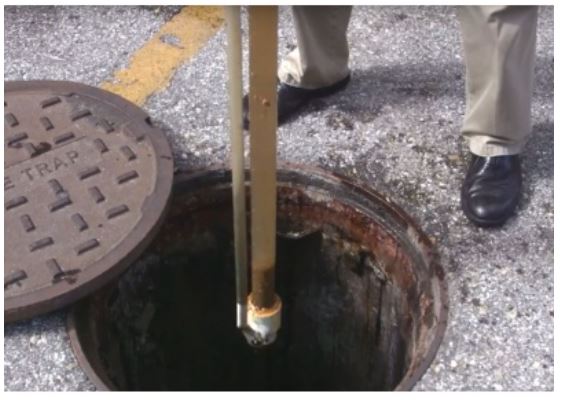
Step 1: Locate the grease trap or grease interceptor.
Step 2: Open the containment lid to the unit.
Step 3: Lower the DipStick Pro sampling tube to the bottom of the outlet side of the grease trap or grease interceptor. When the tube reaches the bottom of the unit, only then close off the sample tube to collect a full sample. When the sample has been taken and the valve to the sampling tube closed, raise the tube back to surface for evaluation.
Step 4: After the sample has been taken, it is now time to calculate the measure of FOG within the measurement tool. This is an easy calculation, and we have given a sample calculation below.
Example:
The FOG measurement sample provides the grease trap is 50 inches in depth. Of this 50 inches, the wastewater make-up is as follows: 30 inches of water, 10 inches of fats/oils/grease, and 5 inches of solids.
Once we have the FOGs composition, we can easily calculate the measurement as follows:
(10 inches fats, oils, grease + 5 inches solids) / 50 inches total depth = 30% FOG
How much FOG is allowed?
The 25% rule is a common standard issued by pretreatment authorities to determine when a grease interceptor is full, but check with your local authorities for FOG requirements. The 25% rule states that the total depth of the floating grease layer plus the settle-able solids layer cannot exceed 25% of the total liquid depth of the interceptor.
While this methodology is widely used for both hyrdromechical (HGI) and gravity (GGI) type grease interceptors, it has no scientific justification when applied unilaterally. Many of the jurisdictions in Orange County California use the 25% rule based on a recommendation in the 2003 Orange County FOG Control Study, which was not based on any science, but rather on a survey of FOG control programs around the US, a significant number of which were using the 25% rule or similar standard, such as maximum inches of accumulation of FOG or solids.
Older type HGIs that are tested and rated to the minimum requirements in PDI G101, ASME A112.14.3 or CSA B481 would certainly qualify to have the 25% rule applied to them. But, while many pretreatment inspectors claim the rule improves system performance, there is still no scientific or technical basis for applying it to GGIs. Moreover, applying the rule unilaterally has some negative consequences. For example, it discourages manufacturers from innovating designs to hold more grease and it negates the benefits a food service establishment would receive in longer and more affordable pump out frequencies that a higher capacity grease interceptor would provide.
In recent years’, some manufacturers, have developed grease interceptors that are tested and rated to have grease storage capacities well more than 50 percent with some models as high as 90 percent of total capacity. The solution for jurisdictions is to simply evaluate these high-capacity HGIs individually to determine their maximum capacity as a percentage of total liquid capacity.


